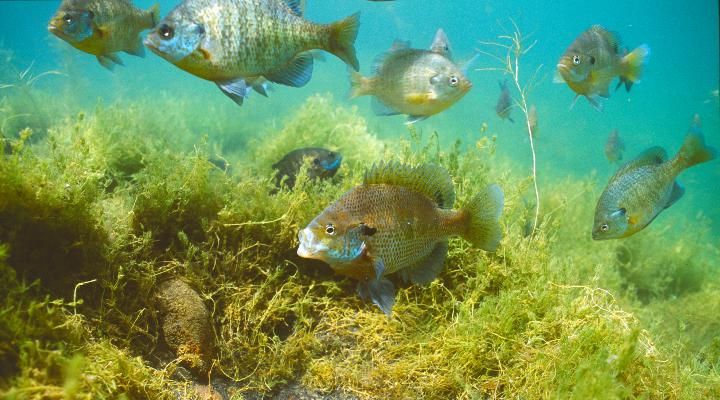
Blog

Best Fish Species to Add to Ponds in the Midwestern United States
March 14, 2023
By Jack Crawford
Ponds are a great addition to any backyard, and one of the essential elements of a healthy pond ecosystem is the fish. Fish play a vital role in maintaining a balanced ecosystem, and selecting the right species can have a significant impact on the pond’s health. In the Midwest United States, there are several fish species to choose from that are well suited to maintaining a healthy ecosystem.
- Bluegill (Lepomis macrochirus): Bluegill is a native midwestern fish species that is hardy and adaptable, making it a good choice for pond owners. Bluegills are a key species in the pond ecosystem, serving as both predator and prey. As a predator, they help to control the population of smaller fish and insects, which in turn helps to keep the pond ecosystem in balance. As prey, bluegills provide a food source for larger fish species like bass. Additionally, bluegills can help to control the growth of aquatic vegetation, which can become overgrown and cause problems if left unchecked.
- Largemouth bass (Micropterus salmoides): Largemouth bass are another native midwestern species that is a top predator in the pond ecosystem. As a predator, largemouth bass play an important role in controlling the population of smaller fish, which can help to prevent overpopulation and maintain a healthy balance within the pond ecosystem. Additionally, largemouth bass can help to control the growth of aquatic vegetation, which can become overgrown and cause problems if left unchecked. Largemouth bass are also a popular sport fish that provide recreational opportunities for pond owners.
- Channel catfish (Ictalurus punctatus): Channel catfish are a hardy and easy-to-care-for species that is popular among pond owners. As a bottom-dwelling fish, channel catfish help to keep the pond clean by consuming organic matter that has settled on the bottom. They also help to control the population of smaller fish, which can help to prevent overpopulation and maintain a healthy balance within the pond ecosystem. Additionally, channel catfish are a popular food fish that provide a sustainable source of protein.
- Fathead minnows (Pimephales promelas): Fathead minnows are a small, hardy fish that is commonly used as forage fish in ponds. They are a key species in the pond ecosystem, serving as a food source for larger fish species like bass. Additionally, they help to control the insect population in the pond, as they feed on larvae and other small insects. Fathead minnows also reproduce quickly, which can help to maintain a consistent food source for larger fish throughout the season.
- Golden shiners (Notemigonus crysoleucas): Golden shiners are a fast-growing species that can adapt to a wide range of water conditions, making them a good choice for ponds that experience fluctuations in water quality or temperature. Like fathead minnows, they are commonly used as forage fish and provide a food source for larger fish while helping to control insect populations. Additionally, golden shiners can help to control the growth of aquatic vegetation, which can become overgrown and cause problems if left unchecked. They are also known for their ability to consume algae, which can help to keep the water clear and improve overall water quality.
When introducing fish to a small pond, it is important to avoid overstocking. Overstocking can lead to an imbalance in the ecosystem, causing problems with water quality and fish health. A good rule of thumb is to add no more than 10 pounds of fish per 1000 gallons of water.
In conclusion, maintaining a healthy ecosystem in a small pond in the Midwest United States requires careful consideration of the fish species that are added. The fathead minnow, golden shiner, bluegill, and largemouth bass are all excellent choices for controlling the growth of algae, aquatic plants, and insect populations, and for providing a sustainable fishing resource. By following the recommended stocking rate, pond owners can ensure a healthy and balanced ecosystem that will provide enjoyment for years to come.
